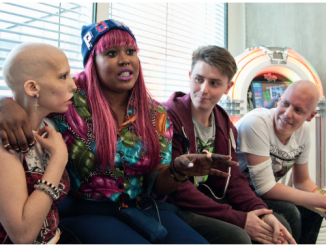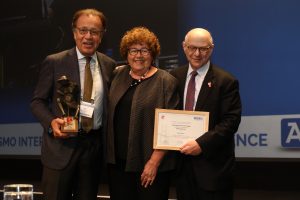
Day two of ABC-Lisbon featured a pioneer in metastatic breast cancer advocacy, Musa Mayer, who gave the ABC Award lecture. Mayer told the history of how the “silent voices” of women with advanced disease came eventually to be heard, greatly helped by the uniting force of online communities. Despite the fears of healthcare professionals, these communities have attracted highly knowledgeable people who have countered the misinformation that often floods the Internet, she said.
Mayer, who told the ABC audience that this is her last conference, is much more than an advocate, having been intimately involved in various evidence-based activities, such as being a patient representative the US Food and Drug Administration, and as an author in studies including on the epidemiology of metastatic breast cancer (MBC – see also her day one advocacy presentation). Researching unmet needs and quality of life has also been longstanding features of her work, and she has been instrumental in helping to unite the MBC groups in both the US and now at global level in the ABC Global Alliance, and always with a searching eye on the evidence.
She said: “I’ve been privileged to witness the birth of a movement, the momentum of which will not be slowed. I feel hopeful for the future in no small part because of the ABC consensus conferences where so many come together for a common purpose. I envisage a time when research and access to care will extend and save lives even beyond what we dream of today. I see a time when these lives will no longer be hidden, when MBC will never again be viewed as a personal failure or a source of shame anywhere in the world. These voices will not be silenced and their numbers will be counted.”
Conversations, support, and side-effects
Later, Mayer also contributed to a session on supportive and palliative care, where she read a moving part from her book, Holding Tight, Letting Go: Living with Metastatic Breast Cancer, in which she told the stories of MBC patients and which in 1997 was ahead of its time. The story she told at the conference illustrated how one woman navigated the process of nearing the end of life with her oncologist and family in a way that was graceful and loving to all concerned. This is in stark contrast to dying in the emergency room of a hospital, as many patients do.
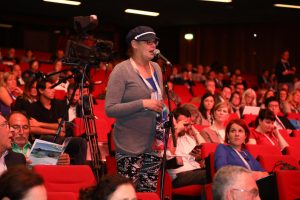 Lesley Fallowfield, also speaking at this session, covered research on doctor-patient communications in the context of a terminal diagnosis and what patients understand about their treatment, and their preferences. Oncologists can be too optimistic with patients they know well, she said, and patients are also too optimistic about the benefits of drugs that show little overall survival benefit, while palliative care options are not discussed with many. Professionals are too negative about good supportive and palliative care, she said.
Lesley Fallowfield, also speaking at this session, covered research on doctor-patient communications in the context of a terminal diagnosis and what patients understand about their treatment, and their preferences. Oncologists can be too optimistic with patients they know well, she said, and patients are also too optimistic about the benefits of drugs that show little overall survival benefit, while palliative care options are not discussed with many. Professionals are too negative about good supportive and palliative care, she said.
Patients must have good information about treatments, and there are good tools that can help with communication, Fallowfield added, such as a “help hurt” scale that has sliders to illustrate benefit-harm, and more training is need to help oncologist handle their professional-personal boundaries. At various points in the conference, including on the consensus panel, she also stressed the imperative for using quality of life (QoL) tools that are appropriate for capturing side-effects of new drugs, given also that many are approved just on progression free survival.
There were specialist presentations too on the management of neurotoxicity, peritoneal carcinomatosis and ascites, and supportive care topics also featured in other sessions. In a clinical challenges session, oncology nurse Christine Boers-Doets from the Netherlands spoke about how to manage side-effects in patients taking oral drugs at home, which is a growing issue. It is important to ask early – within 48 hours – about possible side-effects. “Don’t wait three or four weeks,” she said, adding that the key is to use a systematic method, and mentioned a book she has written on the subject and also the role of Multinational Association of Supportive Care in Cancer (MASCC), a key society in this field.
Later, side-effects were thoroughly discussed in an advocacy session from both a clinician’s and advocate’s perspective. First, Christoph Thomssen, a gynaecologist and breast cancer expert from Germany, described the 5-point scale of severity of side-effects (5 being the worst), saying that even grade 2 toxicities can interfere with daily life. He noted that as many as 50% of oncologists give chemotherapy at first line in oestrogen receptor positive (ER+) breast cancer, but it can be postponed, and endocrine therapy has less severe side-effects.
Thomssen also highlighted techniques such as scalp cooling to avoid hair loss, compression to help prevent peripheral neuropathy with snug surgical gloves, and not least, the benefit of exercise. He was followed by Renate Haidinger, founding member of the German Breast Cancer Association, Brustkrebs Deutschland, who gave a lively talk on everything from keeping teeth and gums in good shape before chemotherapy, to avoiding certain complementary herbs such as St John’s Wort, to coping with effects such as constipation amend nausea/vomiting.
Things got livelier still in this advocacy session, which also covered sex and fertility issues, when Dian Corneliussen-James – known to everyone as “CJ”, and past-president of METAvivor – presented the results of survey on intimacy after a diagnosis of MBC – encouragingly, a majority of women reported that they were still with their partners and indeed relationships for some had strengthened.
Science – luminal and triple negative
Like most days at ABC conferences, the sessions rotated among scientific, clinical and advocacy topics. On the science front, two main breast cancer types, luminal and triple negative, received attention (HER2+ having been covered on day 1). Luminal, comprising types A and B, is the most common molecular characterisation of breast cancer, with the majority also being ER+ and HER2-. Better progress has been made recently with luminal breast cancer, notably with what are called CDK4/6 inhibitors, of which the drug palbocilib has been more extensively studied, but there are others in this drug family.
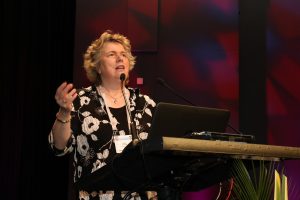
The conference heard from Nadia Harbeck (Breast Centre, University of Munich) on the latest research on the best sequence of agents to use in ER+ HER- cancer, where she said CDK4/6 is now a standard for first line therapy in addition to endocrine therapy (if chemotherapy is not indicated for a crisis stage) as there is a substantial increase in progression free survival (PFS), but not yet an overall survival (OS) benefit. Other agents, including everolimus, an mTOR inhibitor, are also options for endocrine pretreated patients. Harbeck showed the various trials that now give oncologists a wider selection of options of various endocrine therapies alone and with these new targeted agents, so there is much to consider in patient preferences and cancer characteristics now (and not least, whether the new drugs are actually available to patients).
Carlos Barrios, from Brazil, followed up with a discussion of side-effects – inevitably there are new toxicities form the new agents, and longer-term follow-up will be needed to determine safety, and QoL measurement in trials does not always measure real impact. Finally, Stephen Johnson (Royal Marsden, UK) completed the luminal round-up by covering resistance, which is proving to be a big challenge as no biomarkers have yet been found for those who may benefit from CDK4/6 drugs, and there is as yet no clinical answer to what best to do when a patient progresses when taking palbociclib, for example.
Triple negative breast cancer (TNBC) continues to have the least progress, but the conference heard from Aleix Prat (Barcelona) about research that is uncovering more biological information about what is turning out to be a complex and heterogeneous subtype (and itself has basal and non-basal types). There are a number of trials investigating defective DNA-repair pathways, he said, and a possible role for immunotherapy (which may also have a role in HER2+ disease, as heard on the previous day), which was then discussed in detail by Hope Rugo (San Francisco), who said that “TNBC is an attractive prospect for immunotherapy”, and described the various strategies for investigating effect. Using combinations of agents (chemotherapy and checkpoint inhibitors) will be critical. Lisa Carey (University of North Carolina) rounded off the session with more detail on strategies for treating TNBC.
Precision medicine – a tool, not a panacea
For all the investigations into targets for treating MBC, there are still only two that have solid clinical applicability, as George Sledge (Stanford) noted in a talk on the hope and hype of precision medicine. ER+ disease has been known for a long time, while HER2 has also been in play since the 1990s. It is the genomic revolution that has raised a lot more hope, and the cost of even sequencing a whole exome could soon drop to just a few hundred dollars and be affordable at a population level, said Sledge “The hope is that genomic testing will identify actionable alterations and clinical benefit,” he said. But the problem is word “actionable” – that might mean something to researchers, but the more appropriate view, said Sledge, is the patients desire to prolong life and cut suffering.
He painted a somewhat gloomy picture of the attempts to cross-match panels of targeted drugs with various tumours, and noted that less than 40% of drugs approved by the European Medicines Agency (EMA) show survival benefit and only 10% show a QoL improvement. Cancers tend to have more than one driver mutation, he added, also saying that targeting one pathway can inadvertently activate a resistance mechanism. “Precision medicine is real and the technology is evolving rapidly – but it is not a panacea, only a tool,” said Sledge.
Earlier, Fabrice André (Gustave Roussy, France), had detailed that there is only one driver that has level 1 evidence for targetability, and that’s over-expression of HER2 for anti-HER2 therapy. There are another six at level 2, including BRCA1/2, that should lead to clinical trial inclusion, and yet more that could be amenable to targeted therapy. But work so far on testing for multiple genomic alterations has not led yet to clinical utility. Using a large portfolio of drugs, trying to identify the driver mutations and resistance mechanisms, and synergies with immunotherapies are the way forward, he said.
Circulating tumour DNA was assessed by Nicholas Turner (Institute of Cancer Research, London). “It is present in at least 90% of patients with advanced cancer nut at low levels, he said. Currently, it has most promise in detecting changes in the tumour over time – in MBC the key change is acquisition of mutations in the ER gene, ESR1. But while there is evidence of accurate genotyping there is not yet any clinical utility, he concluded.
Clinical challenges and global resources
The remaining sessions on day concerned more practical matters, both clinical and organisational. Maintenance therapies and metronomic chemotherapy were both topics in the clinical challenges session – metronomic therapy involves lower doses with equivalent responses to standard chemotherapy and can also be used in maintenance therapy, which in turn applies to endocrine and targeted therapies as well, and has several aims including prolonging disease control and delaying the use of subsequent, more toxic therapy. There are several statements on metric and maintenance therapies in the ABC consensus guidelines, and the conference heard some new evidence.
Rounding off the challenge was a presentation on older people. Laura Biganzoli, (Prato, Italy) said that at best there are only 10% of older people included in studies of systemic MBC therapy, but there is data that shows that older women (those over 75) have more side-effects and treatment discontinuations than younger patients. Age though has no impact on efficacy, and although it is hard to translate trials to the population level, age should not be a barrier to access, said Biganzoli, although it remains challenging.
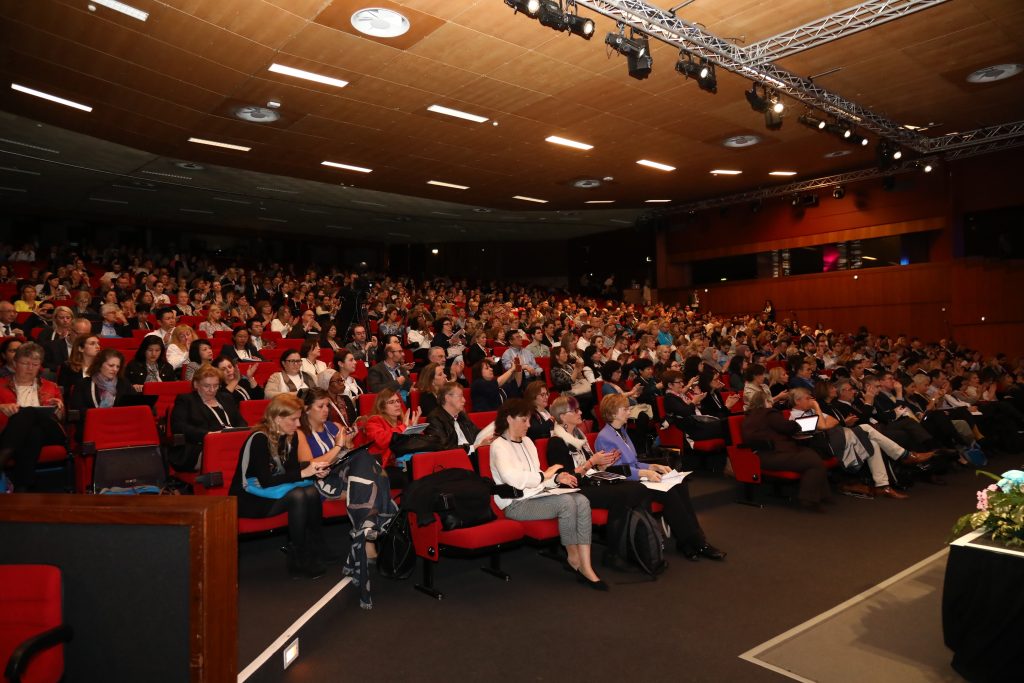
One patient group representative stood up at the end of a session on inflammatory breast cancer (IBC), saying how grateful she was that it was included at the conference. It is not so often featured as it is relatively rare, occurring in less than 5% of cases, said Frederique Penault-Llorca (Centre Jean Perrin, France), but is very aggressive. She gave the latest on the biology of the disease, mainly focusing on genomic profiling studies, and the differences between IBC and non-IBC. A presentation followed on chest wall disease and the complex continuum between IBC and lympangitic breast cancer, and there may also be scope for immunotherapies here too. The role of radiotherapy in IBC was also covered.
Talking of radiation oncology, it was part of a broad session that asked strong questions about whether patients globally have access to even the most basic of treatments. Mary Gospodarowicz (Princess Margaret Hospital, Toronto), spoke about the challenge of providing adequate radiotherapy access to all, mention initiatives such as the Global Task Force on Radiotherapy for Cancer Control (GTFRCC) and the Global Impact of Radiation in Oncology (GIRO) partnership from the European Society for Radiotherapy and Oncology (ESTRO), which are targeting the year 2035 for global equity in access and to save a million lives by then. There are excellent economic arguments to deploy radiotherapy, said Gospodarowicz, but the challenge is not just about equipment but personnel – 30,000 more radiation oncologists and technicians will be needed, and that will not happen given present plans. Radiotherapy plays a crucial role in MBC of course, in treating metastases and controlling pain.
Turning to drugs, Alexander Eniu, a Romanian medical oncologist, said there are still ongoing shortages of common drugs, particularly generics such as tamoxifen, despite their inclusion in the World Health Organisation (WHO) essential medicines list. He pointed to a recent ESMO paper on cancer drug availability outside of Europe and an Economist Intelligence Unit report on shortages in Europe, which has pointers to planning more effectively to cut shortages.
Finally, Timo Schinköthe of Cankado, Germany, gave an interesting talk on e-health – included under the heading “friend or foe”. Cankado is a free digital diary app that allows cancer patients to communicate with oncology teams to manage therapies. As Schinköthe said, this and other projects he described may well prove to be very important in improving patient reported outcomes.
Wrapping up this session, there was a call to talk of “investment” not “expenditure” to convince policymaker to improve services, and to pursue more joined up work with agencies such as the UN – it was mentioned by ABC co-chair Fatima Cardoso that in May this year the World Health Assembly of the WHO adopted a draft resolution, “Cancer prevention and control in the context of an integrated approach”, in which the word “control” now appears in addition to prevention, with implications for MBC and other advanced cancers. But this is not widely known, she said.
Read also the previous article on the ABC Lisbon meeting.




